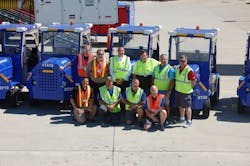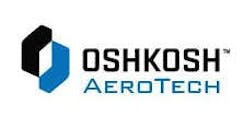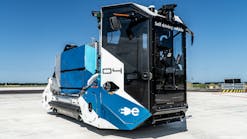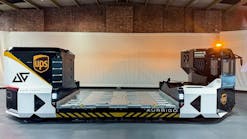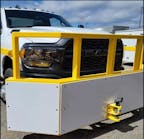As Southwest Airlines sought a powertrain solution to refurb its fleet of baggage tractors, company officials discovered something of significant value – a new process for performing repower projects.
By selecting Kubota as the power source and working in unison with Engine Power Source (EPS) and Powertrain Control Solutions (PCS), Southwest Airlines found an efficient and cost-effective way to refurbish its tractors and recently deployed the zero-timed units at General Mitchell Airport (MKE) in Milwaukee, Wis.
“This is maybe a little exaggerated, but it's like bringing something from the 1970s to current standards,” says Allen Brown, senior manager GSE NE Region at Southwest.
The new process was born in 2016 when the airline was seeking an alternate power plant that would allow flexibility within the program. Brown says that need for versatility is what attracted Southwest to Kubota and PCS.
“The Kubota power plant was very appealing because you can use any of the fuel types with the same footprint of engine within an engine class. It really gave us a lot of flexibility, and then coupling that with the PCS transmission seemed to be a very viable forward-thinking program to get into our fleet,” he explains. “So, we could update the electronics and we could basically upgrade a lot of our fleet at a lower cost.”
With the powertrain selected, the next step was finding a way to do handle installations efficiently.
Individuals from all parties helped develop a concept for a program to streamline the refurb process, making it intuitive to upgrade vehicles regardless of available manpower, geographical location and fleet size, among other factors.
Kevin Boyd, the Southwest manager for Baltimore, and his team took on this project and shaped the package to ensure it worked the way the airline desired. Once engineering was complete, Boyd’s team was able to prove the powertrains could be installed and operated the way Southwest wanted.
“Kevin's group actually took that package and has made it work the way we intended it to work,” Brown recalls.
“This works very well for our refurb program, but we can also do this install down line,” he continues, noting GSE technicians only require lifting tools to install the self-contained kit.
Powertrain Features
Southwest selected the Kubota program so that a particular location could use gasoline, diesel, LPG or CNG to fuel its vehicles.
“It freed us up to be able to compete with the Tier IV final programs,” Brown says. “These Kubota power plants are keeping within the old footprint of the tractors and made it very easy to do an install. So we can take a gasoline, a 4.9 or a 4.2, something that's outdated or that we seem to have problems with, and we've gone to a much more reliable engine source.”
“We’re the only industrial engine company that has an almost fully complementary range of alternative fuels, as well as diesel. It’s all based on the same block – it’s built the same as a heavy duty diesel engine,” explain Kubota company officials. “With the complexity of Tier IV and even Stage V in Europe, we’re seeing a real sway towards those alternative fuels to gasoline.”
Finding a solution that fit in the existing footprint was also a challenge as Brown notes that the after-treatments on many new systems won’t fit in the tractors.
In addition to the refurb, Brown notes Southwest wanted a “package within a package.” That’s where the engineering teams at PCS and EPS came into play, assisting with diagnostic capabilities. He says PCS’s transmission allowed Southwest to utilize the newest technology and tailor the equipment to the airline’s needs.
“The dash we're using serves as a diagnostic tool, but it also brings all of our tractors to a 2018 standard,” Brown notes. “We’re moving into the electronic age. We can do everything right there on the tractor.
“It's given us a ton of latitude across updating all these tractors. We're not just doing an engine change, we put an entire dash package in. It's all one package.”
“Generally, the airlines want a very simple dash for the operator. There’s a few things they need to see – fuel level, temperatures – really, warnings more than anything,” explains PCS president Dan Boucher. “We thought, ‘if they’re already putting a dash on it, why don't we include a tool for the technician as well?’
“Now, the airline can put this vehicle at a location that only has a few pieces of equipment. The technicians may not have a laptop or the diagnostic software. But if they need to perform some troubleshooting on the engine or transmission, they can use the technician’s interface built into the dash to monitor sensor inputs, view a full description of trouble codes, and clear codes.”
Boucher says the biggest value of the transmission is the ability to program the unit to provide anti-abuse, speed monitoring or geo-fencing measures so that the vehicle is operated safely and within operational protocols.
“This package comes with a lot of things that we’ve always tried to incorporate into safety – anti-restart, rolling forward and slamming into reverse. That’s all built into it,” notes Grant Greenwald, northeast regional manager of GSE at Southwest Airlines.
“They put this package together for us and they let us tell them what specifically we wanted and then they went to work and put it together. So, we've only had to do minimal tweaking on the program,” Brown adds. “But we know when these things go out that the engines are certified, and they're installed correctly and that the transmission is installed correctly and everything's operating to its peak.
“I think that's the magic.”
The Hub of the Program
All the players involved in this refurb process became acquainted over time, and their partnership blossomed organically. Soon, everyone involved recognized they had a team capable of accomplishing Southwest’s refurb goal.
Thanks to teamwork, the group was able to ensure all technological components were integrated correctly, and the result was an easy-to-install kit.
“The whole kit, at least the powertrain kit, comes in pre-assembled and is designed to go into that type of tractor,” explains Dudley Greene, OEM sales manager at EPS. “It minimizes the challenges as much as you can, in terms of doing the repower or refurbishment. It minimizes the amount of labor hours it takes to do it, and then it creates standardization.”
Because EPS knows what tractors the powertrains are going into, the company can simply ship kits that arrive with 80-90 percent of what’s needed to upgrade the tractor.
“Instead of having to set up an entire special facility – lines and everything else – to do refurbishments, by pushing a lot of that packaging and assembly back up the supply chain, they can do it in their regular shop without having to retool everything to do a refurbishment,” Greene says. “This approach lends itself extremely well to a region based repower program since the work can generally be performed in a GSE maintenance shop at the airport.
“It’s a more modular approach. It’s a pre-engineered approach, too,” he continues. “PCS, EPS and Southwest worked up front on a couple test-units. Then everything got engineered for those units, and then it rolls out as a kit and is customized for exactly what Southwest wants and needs.”
With the process geared toward assisting the installer, the powertrain can be replaced in about four to five hours.
“And at the end of the day, this entire thing through the Kubota program is certified to be in that piece of equipment,” Brown says. “We don’t have to wonder if it’s going to work long-term.”
Milwaukee Roll-out
Milwaukee was selected as the location for the refurb roll-out because the station had a hodge-podge of power plants.
“This used to be an AirTran city, so we inherited a bunch of equipment from them,” Greenwald explains. “What we had here was diesel tugs, gas tugs, six cylinder gas, V6s. They all started differently. So from a training standpoint, they had to train on all these different vehicles.”
The idea was to take out all of the previous GSE and make the equipment common, so training would be simpler.
What’s more, Brown says it can be difficult to get test results when rolling out a new program or part type across multiple stations because the equipment isn’t always utilized the same. So all 19 of the refurbed tractors were sent to Milwaukee.
The first of the gasoline-powered tractors arrived at MKE in April.
“For Southwest, it’s also one of the first times that we’ve zero-timed a unit for refurb,” Brown explains. “Everything on the tractor, when we take it through the refurb shop, is touched and it’s zero-timed.”
Greenwald raves about the tractors’ reliability, adding the equipment seems as if it’s brand new.
“When they got here, they were being delivered in bunches. One of the assistant ramp managers called me and said he wanted to send one back to the factory because it showed up and had a dent in the back of the cab,” he recalls. “They thought they were all brand new. They didn’t know they were refurbs.”
Harnessing the Magic
Much like Southwest’s fleet of Boeing 737s, the airline seeks standardization on the GSE side of its business, too.
“We're trying to match up our power plants and our technology,” Brown says. “So we're also getting the value out of these units by having newer technology. Because again, they're more dependable, more reliable and you're saving money on maintenance that way.”
In order to determine if a rebuild is worth the investment, Brown says his team looks at the platform and determines if the airline can put 50 percent or less of the cost-of-new into the unit, and put the equipment back out at a regular interval. If so, then it’s a candidate for a repower.
“We still have a replacement program, and for Southwest the refurb program just enhances that. It gives us a little bit more ability to offset purchases,” Brown says. “So we're working with already acquired assets and we're just upgrading them.”
The airline has also modeled the refurb portion of its business like its parts procurement process, using their “Just in Time” method.
“What makes it so quick is we've really fine-tuned the disassembly, the cleaning and repair of parts or assemblies and then the reassembly of the unit,” Brown says. “The guys don't get tied up. Everything that we have ready to go in is there when they need it and they just put it in. So these guys can literally do an entire repower on one unit within a week, from start to finish.”
In order to accomplish this, Southwest has worked with EPS on the timing and scheduling of the powertrains’ arrival. The program’s timeline fits with the reassembly of the unit. When vehicles are pulled out of service, the parts to fix them have been received and are ready.
“The key to this is we, as the distributor, are stocking all the long lead time components. So there’s discussion on big picture vision of what you’re going to do this year to make sure stocking is set up properly,” Greene says.
“And it’s a fully vetted supply chain,” Boucher adds. “It starts with selecting the right, GSE-proven components for the mission and letting EPS do what they’re good at, and letting Southwest do what they’re good at. That’s what’s really made this a success.”
It is believed that maintenance costs will be greatly reduced, especially when considering technicians will all be familiar with these uniform tractors.
“During maintenance and as these tractors age, the technicians will know exactly the areas to monitor and how to efficiently make repairs,” Boucher points out.
Brown believes the repower project, itself, is straight forward. But the teamwork provided by the equipment manufacturers has been key.
“With a partnership, you get away from the sale and purchase, and you get more into problem-solving,” Greene agrees. “The solution either works for all of us and we’re all successful. Or if it doesn’t work for anybody in that chain, then no one is successful.”
“These kinds of projects don't come off the ground and they're not successful if you don't have good support and good partners out there working with you and that's what we have with both Dan's group at PCS and Dudley's group at EPS,” Brown says. “They've lent all their engineering information and strengths to everything we're trying to do. So, it wouldn't be this good of a project without them.
“I think the magic is just being able to work together as a team and get a very good program put out there.”
